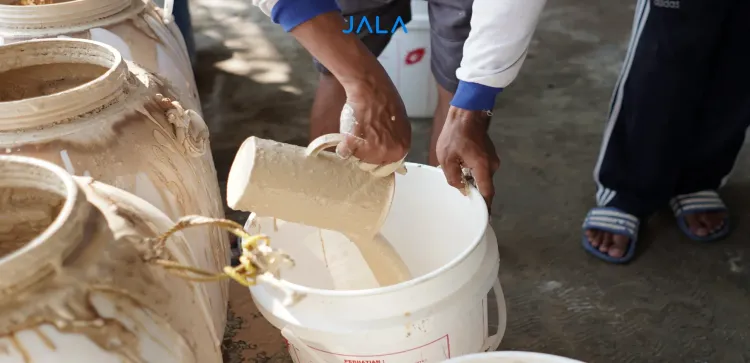
Maintaining water quality is a major task in shrimp farming. Various methods have been developed, and each farmer has a preference for implementing cultivation methods and developing SOPs. One of the methods that has undergone considerable development is the biofloc method or system. This method is basically a shift from an autotrophic system to a heterotrophic.
The definition of biofloc system in shrimp farming
Producing biofloc in the pond means producing colonies of various species, combining biofloc consisting of bacteria, fungi, protozoa, algae, and worms. The floc process that uses nitrogen compounds as shrimp feed is a symbiosis that can stabilize water quality and allow shrimp to grow rapidly.
Biofloc is a combination of different microorganisms, including bacteria, fungi, protozoa, phytoplankton, and organic material from non-decomposed waste. Biofloc technology is environmentally friendly because it can reuse waste from leftover feed and other organic materials to be decomposed into organic colloids. The decomposing of organic material will produce floc, which the shrimp can use as a source of protein.
The basic concept of biofloc is to convert organic and inorganic compounds containing carbon, hydrogen, oxygen, nitrogen and a little phosphorus into sludge in the form of biofloc by using floc-forming bacteria that synthesize biopolymers as biofloc bonds. The primary aim of biofloc technology is to utilize inorganic nitrogen waste in cultivation ponds to become non-toxic inorganic nitrogen. The biofloc system emphasizes the growth of bacteria in ponds to replace the phytoplankton-dominated autotrophic community.
The characteristics of biofloc:
- Minimum water changes
- There’s an addition of a carbon source to increase heterotrophic bacteria
- Emphasizes the C:N ratio of the system
- Nitrogen waste is converted into a high-concentration solid suspension that can be used as high-protein feed
- An effective stirring and aeration to overcome high BOD in the system
Biofloc system implementation
The implementation of the biofloc system from preparation to harvest is by maintaining the concentration of TAN and other nitrogen organic compounds to be converted into heterotrophic bacterial biomass. The conversion will occur when the ratio of organic carbon to nitrogen (C/N ratio) is at 10-20. Heterotrophic bacteria and other organic particles will produce biofloc that contains nutrients, such as protein, fat, carbohydrates, and minerals. Shrimp will use biofloc as a part of their feed. This system will reduce the use of water hence it can increase production cost efficiency.
It is important to note that the production of biofloc must be designed from the beginning since the community shift from autotrophic to heterotrophic dominance is desired to occur as early as possible. The autotrophic system is already so powerful if designed from the beginning, the plankton is already blooming, and it is very difficult to shift it. Community shift in the midst of cultivation is risky since it causes stress and discomfort to shrimp. Under these conditions, shrimp are susceptible to disease.
Molasses can be used to increase the C/N ratio. This treatment is usually applied to cultivation using a biofloc system. Biofloc is obtained by setting the C/N ratio to >10:1, achieved by adding a carbon source (C), one of which is molasses.
The addition of more carbon sources will also increase the population of heterotrophic bacteria in pond water and sediment. An increase in the population of heterotrophic bacteria can be indicated by a decline of foam in the surface and a shift in the water’s color from green to brown. The biofloc method also aims to lower levels of wasted protein from feed hence so as to lessen the load of cultivation waste.
The C:N ratio is calculated by considering the N input that comes from feed, then adjusting the carbon (C) ratio by adding a C source, such as molasses. The amount of feed input is closely related to worsening water quality. The denser the stock, the higher the feed input. Relatively high feed protein (>30%) produces major waste, which are ammonia and organic particles. Heterotrophic bacteria colonize organic waste particles and absorb nitrogen, phosphorus and other nutrients from water. Heterotrophic bacteria can synthesize proteins from organic carbon and ammonia.
Biofloc will be produced if the C:N ratio in the pond exceeds 15. In this system, ammonia and nitrite can be suppressed and mobilized into organic nitrogen in the form of protein as bacterial biomass, one of which also comes from feed protein that the shrimp do not consume. In floc production, sufficient oxygen and pH that is not too low are essential. The minimum oxygen concentration is 4 ppm and the pH is in the range of 7.3-8.3. Bacterial activity will produce lumps that can be utilized by shrimp.
Bacteria which are able to decompose organic waste help produce floc. Several types of bacteria that can be involved as bioflocculant agents are Zoogle ramigera, Paracolobacterium aerogenoids, Bacillus subtillis, Bacillus cereus, Flavobacterium, Pseudomonas alcaligenes, Sphaerotillus natas, Escherichia intermedia, and so on. Some of the types of probiotic bacteria, such as Nitrosomonas and Nitrobacter, can also produce biofloc. These bacteria are already present in the shrimp-rearing medium (pond water), but farmers also add them by applying probiotics, which increases their impact and effectiveness. It is also important to pay attention to the application method and selection of the right probiotics in order to reap the benefits of probiotic use practice.
Advantages and disadvantages of the biofloc system
The biofloc system has the benefits of reducing water changes and increasing feed efficiency. However, in its implementation, the biofloc system in shrimp farming requires strict control to maintain the C:N ratio.
Biofloc has great potential for development because it can be a solution in improving water quality, specifically ammonia, dissolved oxygen, alkalinity, and pH. Implementing the biofloc method can have advantages in maintaining water quality and feed efficiency of up to 10-20%.
References:
Boyd, C. E., and C. S. Tucker. 1998. Pond Aquaculture Water Quality Management. Springer Science+Business Media. New York.
Kusdaryanto, R. 2018. Sistem Bioflok untuk Budidaya Vaname yang Lebih Optimal. MS Bulletin Vol. 40. Hal: 16-18.
Pantjara, B. A. 2010. Nawang, Usman, dan Rachmansyah. Budidaya Udang Vaname Sistem Bioflok. Media Akuakultur, 5(2):93-97
Supono. 2017. Teknologi Produksi Udang. Plantaxia. Yogyakarta.
Supono. 2018. Manajemen Kualitas Air Untuk Budidaya Udang. AURA. Bandar Lampung.





